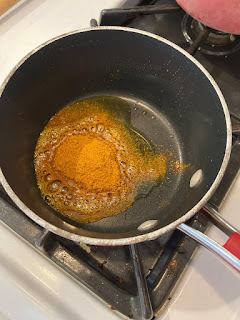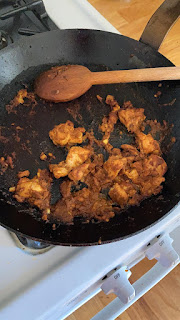Here's another fool proof super tender pan fried chicken tender recipe. [Link to recipe]
Photos are by Catlycocat
This recipe is the acid part of my Simple Chicken Marinade series - enzyme, acid and alkaline.
Additional reading about meat tenderizing:
This recipe uses the lactic acid and calcium in sour milk to further tenderize the chicken, and also protect your meat from heat, leaving you with fantastically tender chicken. It's a different technique to tenderize chicken, and has the added benefit of using the natural enzymes in the meat to break down the collagen, making the meat especially tender.
The below recipe is inspired by Tandoori chicken, but instead of using juicy chicken thighs, we are using the technique to liven up (and tenderize) our chicken breasts. If you adapt this recipe to use chicken thighs, be sure to score the meat so the marinade can better penetrate the proteins.
Yogurt marinades benefit greatly from having a hard hot sear, ideally in a very hot Tandoor (clay oven). These ovens have been used by Indians over 5000 years ago, since the Harappan civilization in ~3000 BC. They are essentially a large clay pot, sometimes buried underground, with a coal fire lit in the middle, for extensive periods of time. Temperatures reach around 480 °C (900 °F) and are kept high for long periods of time. Meats are skewered and lowered into the oven, while flat breads are stuck to the side of the oven to bake. Oils and juices from the meats drip directly into the fire, and the smoke flavors the foods. These ovens are historically used throughout the region, ranging from the Punjab region to Armenia, to Xinjiang in China.
There are lots of dishes that are cooked in a Tandoor, with most of the meat dishes being a variation of something coated in yogurt and spices. A thicker yogurt for this dish would be more authentic, but use what you have.
Yogurt marinade dishes are also found everywhere, from Greek style lambs, to Persian yogurt marinated fish, to Turkish kebabs. I wouldn't be surprised if this ranged as far north as Iceland, and there were historical skyr marinated dishes.
Yogurt marinade dishes are also found everywhere, from Greek style lambs, to Persian yogurt marinated fish, to Turkish kebabs. I wouldn't be surprised if this ranged as far north as Iceland, and there were historical skyr marinated dishes.
| Indian Style Chicken | ||||
| Breast† | 150 | g | 5.3 oz | |
| Marinade | ||||
| Yogurt / Butter milk | 15 | g | 1 | table spoon |
| Tomato Sauce / Paste* | 15 | g | 1 | table spoon |
| Neutral Oil (Or Indian mustard oil) | 5 | g | 1 | tea spoon |
| Ginger | 2 | g | 5mm | or 1/5 inch |
| Garlic | 1-2 | clove | ||
| Fish Sauce** | 12 | ml | 3/4 | table spoon (or 4g of salt) |
| Spice Component*** | ||||
| Chili powder | 6.5 | g | 1/2 | table spoon |
| Coriander Seeds | 6.5 | g | 1/2 | table spoon |
| Cumin | 6.5 | g | 1/2 | table spoon |
| Turmeric powder | 1.5 | g | 1/8 | table spoon |
| Pepper | 1.5 | g | 1/8 | table spoon |
| Mustard seeds | 1.5 | g | 1/8 | table spoon |
| Cinnamon | 1.5 | g | 1/8 | table spoon |
| Cardamon (green) | 1 | pod | a pinch of powder | |
| Garam Masala | 5 | g | 1/3 | table spoon |
| OR | ||||
| Curry Powder or Tandori Masala | 30.5 | g | 2 1/4 | table spoon |
† Feel free to use other chicken cuts, such as thigh, or use this marination technique on lamb chops. Share photos and let us know how it turns out.
* Use fresh tomatoes and mill them, or use ketchup, doesn't have to be too exact.
** We are using a fish sauce that has 1650mg of sodium / 15ml, and making a 1.8% equilibrium brine, where the marinade starts out at a 5-6% salinity. Recalculate the amount of fish sauce needed if your fish sauce is very different from this, or you want a different salinity. Or use salt if you don't have fish sauce.
***As ALWAYS, I recommend that you play around with this component. Use a hotter chili powder, add more chillis, all according to your tastes.
Try different herb mixes, such as lemongrass, garlic, ginger, chili, turmeric, or go Greek with garlic, coriander, oregano, dill, basil, paprika, and onion powder If you have access to things like fenugreek leaves (Kasoori methi) and fennel seeds, it also goes very well with a yogurt marinade.
Another interesting variation might be kimchi and yogurt marinades, blended together. Kimchi is also a lactobacillus type fermentation with a similar ~4.4ph level of acidity.
Prep / Marinade
1) Pick one of the below methods for your spices.
BEST: Use whole spices if possible, making sure to gently toast them before grinding them to powder in a mortar and pestle, before using them in the marinade
GOOD: Warm up the oil first, and throw your spice powders to bloom them before using them in the marinade.
QUICK: Offer an invocation to अन्नपूर्णा as you mix spice powder with the rest of the marinade.
2) Mince your garlic & ginger well. then mix the marinade in a bowl. Alternatively, blend the mixture till smooth (you can use whole tomatoes if you are using a blender).
3) Slice your chicken into flat strips of (optimal size is 6mm / 1/4 inch thick), or cubes, and mix with the marinade in a sandwich bag, squeezing out all the air and placing in the fridge for at least 4 hours - up to 2 days. Ideally 12 hours.
Cooking
Remove the chicken from the bag directly and cook. DO NOT REUSE THE MARINADE, it can be cooked onto the chicken, or made into a sauce.
GRILL: Skewer the meat on a stick (if using bamboo or wooden skewers, soak them in water first), then grill the chicken, turning every few minutes, (optionally basting the chicken in leftover sauce during the first 6 minutes), until the chicken is cooked to an internal temp of 73°C / 165°F , usually within 10-15 min, depending on how hot the grill is.PAN FRY : Starting with a hot pan, sear the chicken for about 3 min sear on each side, then cooking on medium heat for another 4-9 min, or until the chicken is cooked to an internal temp of 73°C / 165°F
Optionally, deglaze your beautiful carbon steel pan with some chicken stock and coconut cream for some extra sauce. OVEN: Preheat your oven to 230°C / 450°F and baking the chicken for 15 minutes (flipping once) or until the chicken is cooked to an internal temp of 73°C / 165°F.
Remove and serve with a squeeze of lemon or a sprinkle of chaat masala on top, and don't forget to give thanks to अन्नपूर्णा after the meal.
GEEKING OUT / SCIENCE
It seems that the weak lactic acid in yogurt (4.3-4.4 ph) or buttermilk (4.4-4.8 ph) works to gently denature meat protein, allowing the meat to absorb more moisture, and making it easier for existing enzymes to break down the protein and collagen within the meat. Stronger acids may TOUGHEN the meat, by squeezing out water from the denatured proteins.
The calcium in milk also seem to also enhance this enzymatic activity, leading to additional tenderizing.
This process takes time (at least a few hours, ideally 12 hours), and unless physically manipulated (vacuum tumbling, or injecting it into the meat) it doesn't penetrate more than the first 6mm / 1/25 inch of the meat from just soaking in marinade in the fridge.
The calcium in milk also seem to also enhance this enzymatic activity, leading to additional tenderizing.
This process takes time (at least a few hours, ideally 12 hours), and unless physically manipulated (vacuum tumbling, or injecting it into the meat) it doesn't penetrate more than the first 6mm / 1/25 inch of the meat from just soaking in marinade in the fridge.
Additional reading about meat tenderizing:
Cat Tax









Comments
Post a Comment